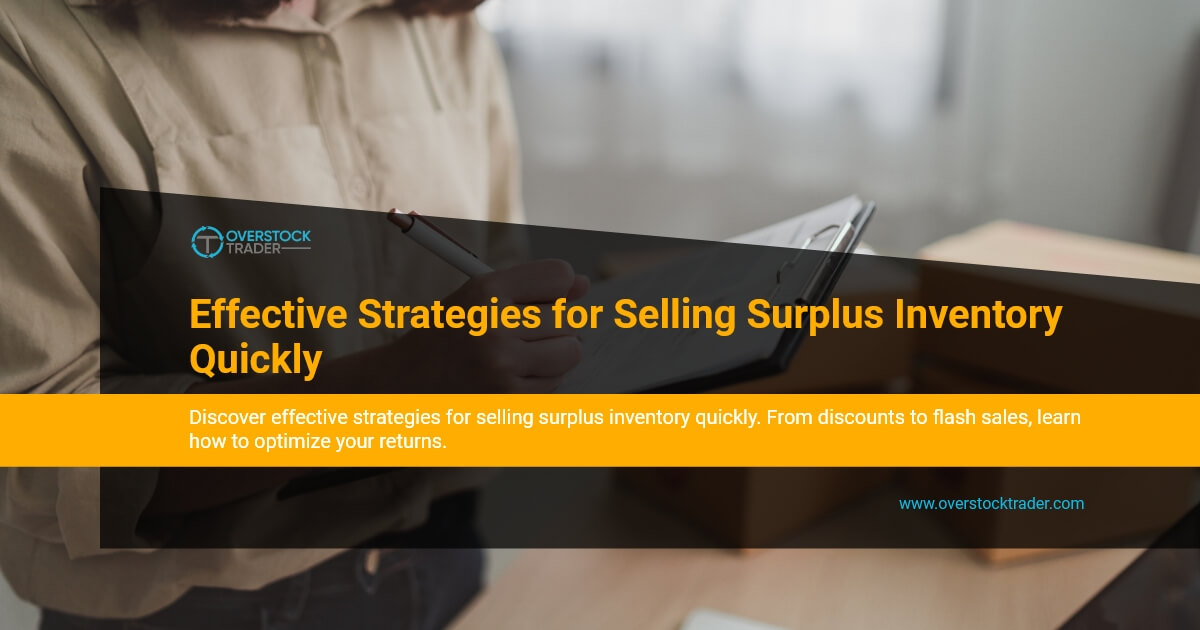Every business deals with inventory, and sometimes you end up with more than you need. This “extra stuff” is called excess inventory, and it can take up space and tie up your money.
But don’t worry! This article shares ways to get rid of that excess inventory quickly and easily, whether it’s because of the seasons changing, products getting outdated, or you just ordered too much. We’ll show you how to turn that “extra stuff” into cash and make room for new things!
Smart Strategies for Selling Surplus Inventory Quickly
When businesses have overstock inventory, it’s important to use smart strategies that can help sell excess inventory quickly. These strategies help reduce financial losses, create space, and maintain a healthy cash flow.
Here are some practical approaches to selling surplus inventory:
Analyze Your Inventory Thoroughly
Before starting the inventory liquidation process, conduct a comprehensive analysis of your inventory. Identify slow-moving or obsolete items, products with short shelf lives, and excess stock taking up valuable space.
Categorize these items based on their condition, demand, and remaining shelf life. This analysis forms the foundation for creating a strategic and efficient liquidation plan. Similar to tidying up a living space, this process allows for new opportunities and ensures a streamlined and organized business model.
Offer Discounts and Bundles
Initiating the inventory liquidation process is greatly bolstered by the strategic implementation of discounts. Offering markdowns on slow-moving or excess inventory serves as a powerful and direct method to invigorate sales. The significance of discounting cannot be overstated, as it not only accelerates the clearance of surplus stock but also holds the potential to entice a new wave of customers actively seeking cost-effective options.
Consider employing tiered discount structures for bulk purchases, enticing customers with the prospect of greater savings as they buy in larger quantities. Additionally, bundling related products to create attractive deals presents a win-win situation – customers enjoy the value of combined items at a reduced cost, and your business efficiently moves diverse inventory.
The importance of this discounting strategy extends beyond the immediate goal of inventory reduction. It acts as a dynamic tool to capture the attention of price-conscious consumers, fostering customer loyalty and potentially converting one-time buyers into repeat customers. By strategically navigating the realm of discounts, businesses not only optimize their liquidation efforts but also lay the foundation for sustained customer engagement and long-term success.
Use Flash Sales and Limited-Time Promotions
Once you’ve commenced discounting and bundling, you can further elevate your inventory liquidation strategy by incorporating more dynamic approaches, such as flash sales and limited-time promotions. Creating a sense of urgency through these tactics adds an extra layer of excitement to your offerings, compelling customers to make quicker purchasing decisions. The urgency instilled by flash sales and limited-time promotions is particularly effective in minimizing the time your products spend sitting on shelves.
By being a little more aggressive with time-sensitive promotions, you not only heighten the attractiveness of your deals but also tap into the psychology of consumers who fear missing out on valuable opportunities. This strategic maneuver not only accelerates the pace of inventory turnover but also cultivates a sense of anticipation among your customer base.
To maximize the impact of these time-sensitive promotions, leverage various marketing channels such as email newsletters and social media platforms. Craft compelling messages that highlight the exclusivity and immediate nature of the offers, driving traffic and engagement. Utilizing these channels effectively ensures that your target audience is well-informed about the limited-time opportunities, thereby optimizing the success of your flash sales and promotions.
Partner with Discount Retailers and Distributors
After exhaustively employing discounting strategies, the next step in optimizing your inventory liquidation is to consider partnering with discount retailers and distributors. Collaborating with businesses that specialize in surplus or discounted products presents a potent avenue for swiftly and effectively moving excess inventory. By establishing robust relationships within this niche, you tap into a network that is specifically attuned to the dynamics of surplus stock, ensuring a streamlined and efficient process.
When you partner with discount retailers and distributors, you leverage their expertise in marketing and selling discounted items. This not only enhances the visibility of your products in the market but also positions them in front of an audience actively seeking budget-friendly options. The synergy between your surplus inventory and the specialized focus of these partners creates a symbiotic relationship where both parties benefit.
Furthermore, this collaborative approach extends beyond mere inventory liquidation. It serves as a strategic expansion of your distribution network, potentially opening up new markets and customer segments. By diversifying your distribution channels, you mitigate the risk of overstock in the future and create a more resilient and adaptive business model. In essence, partnering with discount retailers and distributors not only facilitates efficient inventory liquidation but also lays the groundwork for sustained growth and market presence.
Consider Donating or Liquidating to Charities

Once you have already engaged discount retailers and distributors to move your inventory, exploring philanthropic avenues such as donation becomes a strategic and socially responsible choice, offering a win-win scenario for both your business and the community at large. Consider donating excess inventory to reputable charitable organizations, aligning your business with a noble cause while simultaneously creating a positive impact on those in need.
One significant advantage of this approach is the potential for beneficial tax implications. Many jurisdictions offer tax deductions for businesses that contribute to charitable causes, including in-kind donations. By leveraging these tax advantages, your business not only fulfills its social responsibility but also gains financial benefits through reduced tax liabilities.
To further amplify the impact of your philanthropic efforts, consider organizing liquidation auctions where the proceeds are directed towards charitable endeavors. This innovative approach combines the goals of inventory liquidation with a commitment to social responsibility. The dual purpose of these auctions is not only to clear out surplus stock but also to contribute to meaningful causes.
Beyond the immediate financial and tax benefits, adopting a socially responsible approach can significantly enhance your brand image. Consumers increasingly value businesses that demonstrate a commitment to social and environmental causes. By integrating charitable donations into your inventory liquidation strategy, you not only strengthen your brand’s reputation but also foster customer loyalty and trust.
Want to know the value of your inventory?
Conclusion
Liquidating inventory requires a strategic and thoughtful approach to minimize losses and maximize returns. By combining discounting strategies, online market presence, partnerships, and philanthropy, businesses can efficiently clear excess stock while maintaining a positive brand image. Regularly review and update your inventory management practices to prevent future overstock situations and ensure a healthier, more agile business model. Additionally, platforms like Overstock Trader can provide valuable assistance in connecting businesses with buyers for their surplus inventory, streamlining the liquidation process.
Frequently Asked Questions
What is excess inventory and why is it a concern for businesses?
Excess inventory refers to stock levels that exceed the current demand or storage capacity of a business. It can tie up capital, occupy valuable storage space, and lead to financial losses if not addressed promptly.
How can I sell my excess inventory quickly?
There are several ways to sell excess inventory quickly. You can consider offering discounts, bundling products, using flash sales and limited-time promotions, collaborating with discount retailers or distributors, or even donating to charitable organizations. These strategies help create urgency and attract customers to purchase the surplus stock.
What is liquidation, and how does it relate to excess inventory?
Liquidation is the process of converting assets, including excess inventory, into cash. It involves selling off surplus or unwanted stock to recover some of the investment made in purchasing the inventory. Liquidation can help businesses recoup losses, free up storage space, and generate cash flow.
How can I avoid getting stuck with excess inventory in the first place?
Good inventory management is key! Regularly track your inventory levels, forecast demand accurately, and avoid impulse purchases. Consider offering pre-orders or made-to-order options to reduce the risk of overstocking.

